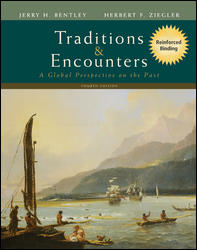
Traditions and Encounters, 4th Edition (Bentley)Chapter 15: THE RESURGENCE OF EMPIRE IN EAST ASIAOverviewAfter the fall of the Han dynasty, more than 350 years of disruption plagued China. Toward the end of the sixth century, centralized imperial rule returned to China and persisted for almost 700 years under the Sui, Tang, and Song dynasties (589–1279 C.E.). This period witnessed unprecedented economic prosperity for China. In addition, China, as the "Middle Kingdom," made its influence felt throughout the surrounding territories, creating a larger East Asian society centered on China. This period of East Asian history is characterized by:
|  |















